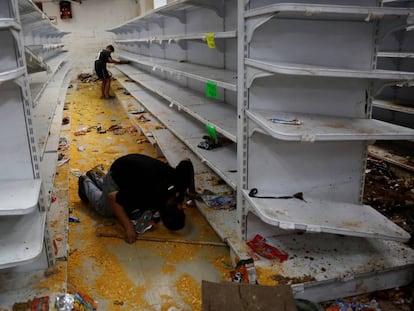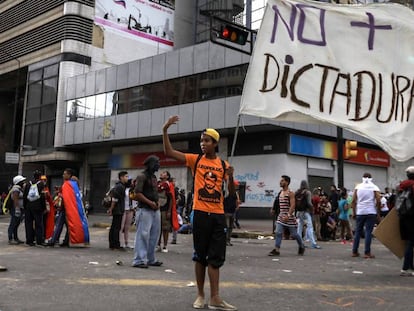The average victim of protest violence in Venezuela: a student on the frontlines
Attorney General releases death toll over the last four months, evidencing effects of collapsing economy
Venezuela’s Office of the Attorney General has released a report documenting deaths during protests against the administration of President Nicolás Maduro held between April 1 and July 27. While the death toll at the time of the report’s release was 109, there have since been a further 12 victims, for a total of 121.

The study also shows that most of the victims are male, and aged 27 on average. But as many as 11 were underage.
Nearly all were killed as they stood on the frontlines of the opposition-led protests against the United Socialist Party (PSUV) government. They were part of a grassroots “army” of activists who call themselves La Resistencia and who face riot police with makeshift shields built with wood, cardboard or satellite dishes.
The best-known of these victims is Neomar Lander, who was hit in the chest with an object that caused fatal injuries. His colleagues accused the military police of shooting a tear-gas canister at him at close range.
A similar fate befell Pablo Pernalete, a 20-year-old accounting student who was brought in with a chest injury.
There are only seven women on the list, one of them hit by a frozen bottle that somebody hurled out of a building
Public opinion had long held that many of the fallen in combat were university students, and the new report appears to confirm this impression. Of the victims tallied to July 27, 26 of them were students. Others had just graduated: Adrián José Duque, a 23-year-old public accountant, was shot in the stomach as he was protesting in Maracaibo, the capital of the oil-rich state of Zulia.
Pernalete, Lander, the social communicator Miguel Castillo and the violin player Armando Cañizález – who used to play with the world-famous, state-funded Sistema de Orquestas Infantiles y Juveniles de Venezuela – are the victims that the opposition most identifies with.
But not all victims died during clashes with government forces. In Valencia, in the central state of Carabobo, and in El Valle, a parish in southwestern Caracas – a sector that Chavistas had always boasted about controlling until their defeat at parliamentary elections in December 2015 – many people vented their anger at the chaotic living conditions that are the legacy of the late Hugo Chávez’s economic model by looting businesses. In Valencia, looters destroyed an industrial sector that was supplying the central part of the country. And in El Valle, several individuals attempted to loot a bakery one night in April, resulting in eight of them being electrocuted as they tried to get at the food.

There are only seven women on the list of fatalities, and one of them is Almelina Carrillo Virguez, a 52-year-old waitress who was hit by a frozen bottle that somebody hurled out of a building as she was walking to work. Her death was used by the regime to decry the violent nature of the protests, and to persecute individuals who are perceived as instigators. The sociologist Tulio Hernández, who now lives in exile in Spain, was targeted by official media outlets and by Maduro himself over that case.
Chavistas also made a banner out of Orlando José Figuera Esparragoza, a 22-year-old who was walking home from work when he ran into a man with whom he’d had a knife fight over a job opening. The man was back for revenge. Figuera was wounded again, like he had been the first time. But then the attacker, according to the investigation, began screaming that Figuera was trying to steal from him. Other individuals – whom the government claims are involved in the violence against the riot police – ran to the scene, where they also stabbed Figuera, then doused him in gasoline and set him on fire. His horrible fate made daily headlines on pro-government media outlets from the day of the attack, May 20, until his death on June 4.
English version by Susana Urra.
Tu suscripción se está usando en otro dispositivo
¿Quieres añadir otro usuario a tu suscripción?
Si continúas leyendo en este dispositivo, no se podrá leer en el otro.
FlechaTu suscripción se está usando en otro dispositivo y solo puedes acceder a EL PAÍS desde un dispositivo a la vez.
Si quieres compartir tu cuenta, cambia tu suscripción a la modalidad Premium, así podrás añadir otro usuario. Cada uno accederá con su propia cuenta de email, lo que os permitirá personalizar vuestra experiencia en EL PAÍS.
¿Tienes una suscripción de empresa? Accede aquí para contratar más cuentas.
En el caso de no saber quién está usando tu cuenta, te recomendamos cambiar tu contraseña aquí.
Si decides continuar compartiendo tu cuenta, este mensaje se mostrará en tu dispositivo y en el de la otra persona que está usando tu cuenta de forma indefinida, afectando a tu experiencia de lectura. Puedes consultar aquí los términos y condiciones de la suscripción digital.
More information
Archived In
Últimas noticias
Most viewed
- Pablo Escobar’s hippos: A serious environmental problem, 40 years on
- Reinhard Genzel, Nobel laureate in physics: ‘One-minute videos will never give you the truth’
- Why we lost the habit of sleeping in two segments and how that changed our sense of time
- Charles Dubouloz, mountaineering star, retires at 36 with a farewell tour inspired by Walter Bonatti
- The Florida Keys tourist paradise is besieged by immigration agents: ‘We’ve never seen anything like this’










































